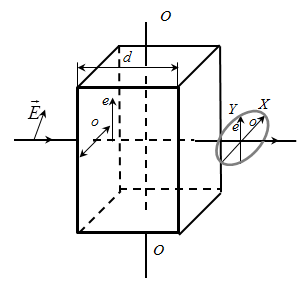main
To the list of lectures
|
§4 Polarizing prisms and polaroids Polarization devices
is a device by which the natural light of the possible, to get a plane
polarized light. The basis of the polarization devices based on the
phenomenon of birefringence.
The prism (Scottish scientist 1768-1851) is a double prism of Iceland spar, glued along the line AB Canada balsam, with n = 1.55. The optical axis OO' prism of the inlet face angle 48°. On the front face of the prism natural beam, parallel to the edge CB splits into two beams: the ordinary (nO = 1.86) and extraordinary (ne = 1.51). An appropriate choice of the angle of incidence equal to or greater limiting (critical) ordinary ray undergoes total internal reflection (as Canada balsam for him - the less dense medium), and then is absorbed by the blackened surface of the CB. Extraordinary beam exits the crystal parallel to the incident beam slightly offset relative to the incident (due to refraction at the edges AC and BD). Birefringent prism using the difference in the refractive indices of the ordinary and extraordinary rays in order to separate them as far as possible from each other. They are made of Iceland spar and glass, Iceland spar prisms with perpendicular optic axes. Birefringent crystals have dichroism (di - two, chrome - color) - the absorption of light depends on the orientationand the direction of light propagation in the crystal and the wavelength. Dichroism phenomenon manifests itself in different colors of crystals in different directions. An example of a dichroic crystal tourmaline - uniaxial crystal, which is absorbed by the ordinary ray is much more unusual. Even more pronounced dichroism have crystals herapathite (quinine sulfate iodine). Herapathite film thickness of about ~ 0.1 mm fully absorbs the rays of ordinary visible light. Dichroic crystals are used for the manufacture of polaroids - thin crystalline films, allowing to obtain a plane polarized light.
§5 The analysis of polarized light Plane-polarized light within the crystal plate is divided into ordinary and extraordinary. On exit from the rays of the plate will be formed and give elliptically polarized light:
Between ordinary and extraordinary rays in the plate there path difference
or the phase difference
plate with
called a quarter-wave plate (plate
If the light is incident on the
called a half-wave plate.
§ 6 Artificial optical anisotropy Several crystals are isotropic, as a result of external influence becomes optically anisotropic. Artificial anisotropy can cause: mechanical action (compression or tension) cubic crystals, glasses and other amorphous solids. In all cases, external influences substance acquires the properties of a uniaxial crystal (ie becomes birefringent), the optical axis coincides with the direction of strain, electric and magnetic fields.
where σ - elastic deformation. k1 - a constant characterizing the material.
k2 - a constant characterizing the material.
where H - the magnetic field,
|





